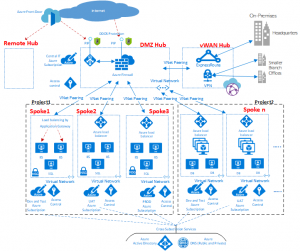So before we talk about Hub & spoke specifically in order to achieve the Azure virtual data center Architecture , I would like to share with you some details about the Azure virtual data center and from now on let us use the abbreviation Azure VDC that means (Azure Virtual Data Center )
So Azure VDC it is not a product from Microsoft as I mentioned in the video but it’s a kind of methodology that is used when you want to extend your on premises data center to the Azure cloud
Hub and spokes is a model for extending a Virtual Data Center within a single Azure region.

Image Source : https://docs.microsoft.com/en-us/azure/architecture/vdc/networking-virtual-datacenter
And as per the description from Microsoft Azure website :
The VDC can help enterprises get workloads and applications into Azure for the following scenarios:
- Hosting multiple related workloads
- Migrating workloads from an on-premises environment to Azure
- Implementing shared or centralized security and access requirements across workloads
- Mixing DevOps and Centralized IT appropriately for a large enterprise
Considerations on Implementing a Virtual Data Center
When designing a VDC, there are several pivotal issues to consider:
- Identity and Directory Services
- Security infrastructure
- Connectivity to the cloud
- Connectivity within the cloud
And from here I will start talking about the Hub & Spoke series which will be focusing into deep on points (3 & 4)
Connectivity to the cloud
So the 1st step in order to cut it short and don’t find surprises in the middle of the project when you are trying to connect your Data center to Azure , some point you have to consider 1st
- The nature the workloads will be hosted or extended in Azure (DB , App Server , Web Servers ,etc .. )
- Speed limitations of your Data center internet connection
Then you start to choose between 2 ways how to connect to Azure cloud
Or
Considering all constraints mentioned in the above mentioned links and also features that you need for your solution or you don’t need so for example :
VPN connectivity is mostly used when you decide to use only IaaS Services and some PaaS with Maximum speed of 1.25 Gbit/s
While Express routes can be used when you need to make full connection for long term using almost all services in Azure integrated with your Datacenter and Maximum speed can reach 10 Gbit/s
The next 4 remaining parts in the series I will be talking about Connectivity within the cloud in deep technical details and considerations including how to and cases.
Stay tuned.
